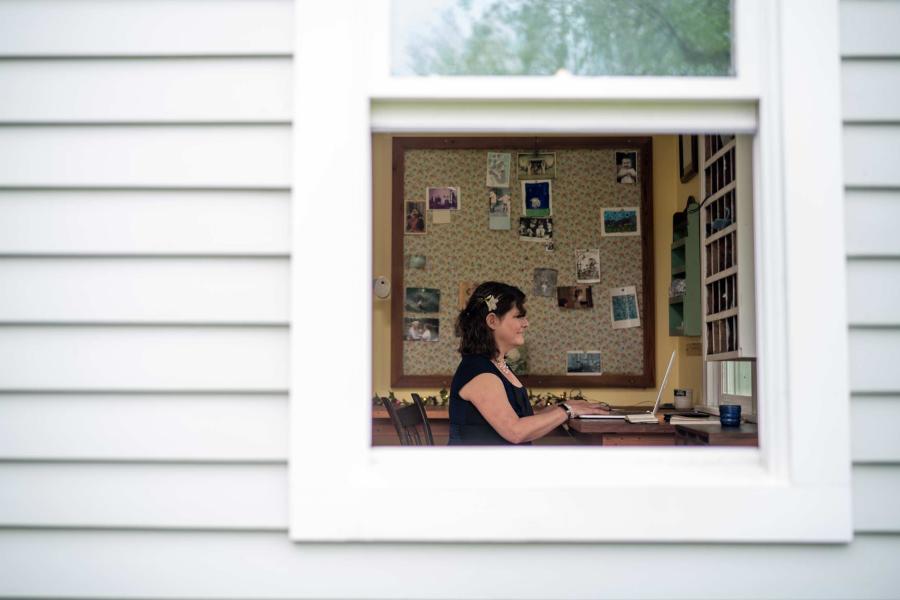Imagine you’re on Grounds, early in the morning at the University of Virginia. You have just enough time to grab breakfast at Bodo’s Bagels before dashing to class. You cut across the Lawn, passing students and catching snatches of their conversations. Birds chirp. A group of runners jogs by, their feet pounding the brick path (maybe UVA President Jim Ryan is among them). In the distance, you hear cars humming down University Avenue.
Once in Bodo’s, you stand elbow-to-elbow in line. Clatters from the kitchen mingle with the cacophony of people talking and eating. “Order 93!” calls the man behind the counter, dropping your bagel into a paper bag and sliding it onto a tray. You glance at your watch. If you hurry, you will have just enough time to make it to class. You race back across the Lawn, making it to your seat just as the University Chapel bells chime the hour.
Your Daily Soundtrack
While unique, each of these moments has something in common: sound.
Wherever you go, sounds accompany you, weaving together to create an ongoing and ever-changing sonic experience so integral to your daily life it’s possible you barely notice it.
◄ Back to Story
01. Morning at Bodo’s Bagels
01. Morning at Bodo’s Bagels
00:21
Transcript
Cash register beeping, murmur of people chatting and eating, ice clanking, plastic trays sliding across the counter
But what if you did notice? What if you paused and paid attention to the muffled sound of the television in the next room? The low rumble of the dryer? The soft tapping of rain on the window pane?
Then, what if you took it a step further? What if you noticed how these sounds affect you?
That’s exactly what UVA English professor Steph Ceraso wants to find out.
Re-Tuning Your Senses
Ceraso, an assistant professor of digital writing and rhetoric in UVA’s Department of English, has spent her academic career probing these questions. Through the publication of her recent book, “Sounding Composition: Multimodal Pedagogies for Embodied Listening” and her classes, such as “Digital Humans,” “Music, Writing, Identity” and “Experiments in Learning,” among many others, she is helping advance her field while also tuning her students’ minds – and ears – to an enriched way of encountering the world.
“Sound plays an undeniable role in shaping experiences of all kinds,” Ceraso writes in her recent book. “As educators, we cannot afford to ignore sound or brush it off as less attention-worthy than the visual. There is a genuine need for new pedagogical approaches that can help students cultivate critical listening … in both scholarly contexts and in their daily lives.”
◄ Back to Story
02. Afternoon in the East Gardens
02. Afternoon in the East Gardens
00:25
Transcript
Birds chirping, footsteps crunching on gravel, light breeze
In a recent interview, Ceraso expanded on her call for incorporating sound into higher education curriculums, her research and more.
Sound is such a fundamental part of the day-to-day human experience. Yet you mention in your book that there are few resources that provide examples or methods for teaching with sound. How can the study of sound enrich and enhance other disciplines?
While students often come to college with some experience analyzing images or maybe even producing a simple video, they rarely have any scholarly training in thinking about sound or listening in a critical way. Helping students develop sonic literacy isn’t the job of a single discipline. Sound is a complex, transdisciplinary topic that needs to be tackled from multiple perspectives; plus it’s a pervasive experience that affects our daily lives.
Also, regardless of the field you are working in, listening is a crucial practice – especially considering the divisive social and political climate we currently find ourselves in. Teaching students to really listen – to become sensitive to not only what others are saying and feeling, but to how sound is shaping their experiences more broadly – is incredibly valuable.
You write about how we have never been more in control of manipulating and personalizing our own sonic experiences. How has this changed our relationship with sound and listening?
Technologies have given people a lot more control over their individualized soundscapes. Sometimes that’s a good thing.
For instance, creating customized playlists on smartphones can help us modulate our moods or motivate us to work out or study; wearing noise-cancelling headphones on public transportation can give us a sense of privacy so we can focus on our own work or entertainment.
◄ Back to Story
03. Printmaking Class in Ruffin Hall
03. Printmaking Class in Ruffin Hall
00:17
Transcript
Soft murmur of students and instructors, industrious crank of machinery
However, this kind of sonic control comes at a cost. When people lose themselves in their personal soundscapes, they often miss opportunities to listen to environmental sounds that can provide salient information about the places they are traveling through.
More significantly, when people create their own sonic worlds, they cut themselves off from potential interactions with those around them. Personal soundscaping enables individuals to stay in their own bubbles, isolating them from others in their immediate communities.
◄ Back to Story
04. Front steps of Alderman Library
04. Front steps of Alderman Library
00:24
Transcript
Soft breeze, footsteps scuffing on marble steps, bus driving by in the distance, creak of the automatic door swinging open, clank of door closing
I’m not saying that people should stop plugging in to technologies, but we should all understand when and why it might be important to unplug.
You write extensively about the relationship between sounds and the body. However, many people walk around pretty oblivious to the impact sounds have on their internal experiences. What are some of the benefits of becoming more aware of this relationship?
When and if sound is discussed in academic settings, it tends to be all about meaning. What does this sound mean? How should we interpret it? But that approach flattens sound by treating it as a static object that can be studied rather than an experience that moves and affects people.
◄ Back to Story
05. Waiting at the McCormick Road bus stop
05. Waiting at the McCormick Road bus stop
00:46
Transcript
Bus driving up to bus stop and stopping, hiss of air as the bus lowers to the curb, creak of doors opening, passengers stepping off, shuffle of footsteps
Paying attention to how sound affects people in various ways can help students understand their own embodied relationships with the sonic world – how sound makes them feel or behave in certain settings, and how their own bodily identities (including race, gender, class, etc.) may shape how they think or feel about different sonic experiences.
This kind of attunement to embodied experience can also help students become more savvy designers of sonic media. In other words, understanding how sound affects listening audiences involves more than making meaning of sound. It requires a sensitivity to how sound works and how it can shape our bodily experiences.
◄ Back to Story
06. Starbucks on the Corner
06. Starbucks on the Corner
00:18
Transcript
Students chatting loudly, creak of the door opening and closing, clatter of ice, smooth voice of a female singer floating through overhead speakers
Like any place, UVA has a host of signature sounds, from the bustle of the early morning rush at Bodo’s, to the staccato of new construction, to the hush of the Rotunda. Can you elaborate on how these sounds inform our sense of UVA?
Every semester I go on “soundwalks” with students. I ask them to listen closely to the soundscape of UVA – to what sounds they hear and how their bodies feel in particular locations on Grounds.
One of the most striking features of these walks is the persistent sound of construction and maintenance. UVA is rarely peaceful-sounding, at least during the day. We end up talking about how different the sonic experience of Grounds is compared to the idyllic images on UVA’s website and other marketing materials. Those images project a sense of quiet and calm, but a lot of disruptive noise is necessary for maintaining the well-manicured lawns and historic buildings.
◄ Back to Story
07. McGregor “Harry Potter” Room
07. McGregor “Harry Potter” Room
00:18
Transcript
Hush of a nearly silent room, punctuated by shuffling papers, soft typing on laptop keyboards
We also talk about how the most concentrated areas of construction noise can tell us about where the University is investing money, or about what it values most at a given moment in time.
What originally drew you to your field?
I was drawn to the field of writing and rhetoric because it’s so capacious and interdisciplinary. It encompasses a wide range of scholarly areas, which I find exciting.
Most of all, though, I love that my field takes pedagogy seriously. Teaching matters in my field, and that is reflected in scholarship and practice. Not many disciplines can claim that.
Over the course of your career, have you noticed any changes in your field? How has it evolved? Where do you see it going?
When I was a graduate student, teaching students to produce digital media was not as widely accepted. I think people now recognize the importance and relevance of teaching students to produce projects that go beyond written language alone.
What’s one of the most rewarding aspects of your job?
I love working with and mentoring students, both undergraduate and graduate. Teaching is by far the most rewarding part of my job because I get to see students grow and evolve as thinkers and authors. I’m always inspired by students’ creative approaches to digital projects and their willingness to try things that they’ve never done before. I learn a lot from my students.



